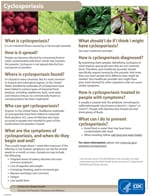Surveillance & Outbreak Response
CDC conducts surveillance for cyclosporiasis. Surveillance is the ongoing collection and analysis of data and the timely dissemination of information to those who need to know so that action can be taken. Cyclosporiasis is a nationally notifiable disease, that is, a disease for which regular, frequent, and timely information regarding individual cases is considered important for its prevention and control. Cyclosporiasis is a reportable disease in 43 states, the District of Columbia, and New York City. Regardless of whether cases of cyclosporiasis ares reportable in a particular state, it is important for the public and clinicians to inform their local health department about potential cases and clusters of the disease so that appropriate actions can be taken to help prevent additional cases of illness.
Even single cases of cyclosporiasis—not just obvious clusters of similar cases (such as after a social gathering or other event)—should be reported. CDC, in collaboration with public health authorities, analyzes each reported case for epidemiologic evidence of linkage to other cases, to facilitate rapid identification and investigation of outbreaks. No validated molecular tools are available yet for linking C. cayetanensis cases; CDC and other agencies are working to develop and validate such tools.
